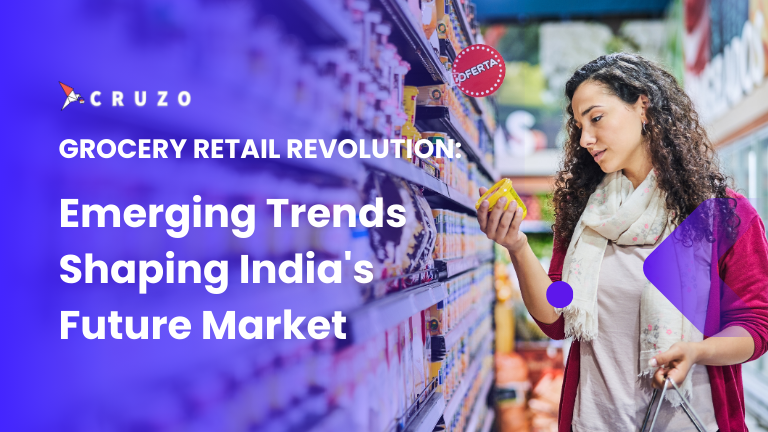
When markets evolve and all industries are obliged to innovate, it’s difficult. The game of the grocery retail industry in India, in particular, has changed dramatically in today’s social distance-minded economy. Grocery stores played a critical role in society when lives and livelihoods were at risk. Plagues and pandemics have occurred before, but food shopping has changed dramatically in the last 200 years. The act of purchasing is not changing; what is changing is the manner in which the client will purchase.
From haats to weekly bazaars, local stores, mom-and-pop shops, and new-age experience mall culture, the future of grocery retail in India have undergone various changes. The latest buzzword, the “new normal,” is ushering in new retail trends and developments. Even during Diwali last year, Indian e-commerce saw an increase in e-groceries rather than electronics or large items, as it had the year before.
Some Examples
To help with fulfillment, Reliance Retail, India’s largest brick-and-mortar retailer, has JioMart stores in 200 cities, an 800-store network, and a growing network of kirana stores. Reliance has raised a staggering $26 billion to expand its retail and JioMart businesses. JioMart’s payment and client order monitoring should be possible thanks to the Facebook-WhatsApp partnership.
Amazon’s footprint comprises of More Retail’s 600+ store network (purchased from Aditya Birla Group) and 60 warehouses with a total storage capacity of more than 32 million cubic feet, supporting more than 6.5 lakh sellers. In 2019, Amazon bought an indirect share in Future Retail, the owner of BigBazaar and 1,300 supermarkets, which appears to have gotten into trouble after Reliance bought Future Group’s retail, wholesale, and logistics businesses. Jeff Bezos has also pledged to invest $6.5 billion.
Tata Group, on the other hand, is considering a $1.6 billion takeover of Alibaba-backed online grocery company BigBasket. This is in addition to DMart, India’s second-largest grocery chain by revenue, which is experimenting with e-commerce.
“Groceries have become the focal point during this season when people are remaining at home and not socializing.”
The small role that e-grocery used to play in e-commerce (less than 5%) is changing.
“Currently, online food and grocery retail hold a minuscule fraction of online retail with only 0.2 percent penetration,” according to a report, “but it is expected to increase by 55 percent to reach 1.2 percent of the market by 2023.”
Customer in the Future
“There is no sincerer affection than the love of food,” as George Bernard Shaw once said. Despite the difficulties, the food retail industry rose to meet the pandemic’s challenges. The sector has dealt with shifts in customer purchasing patterns as well as the introduction of new consumer niches. According to the EY Future Consumer Index, the five new consumer sectors are ‘Back with a Bang,’ ‘Stay Frugal,’ ‘Keep Cutting,’ ‘Cautiously Extravagant,’ and ‘Get to Normal.’ This epidemic has given the grocery industry a boost, and these categories have aided in capitalizing on that boost.
The growth of the online grocery market has quickened, with start-ups raising $665.7 million in funding in 2019. This online grocery dream is predicted to reach $1.5 billion by 2023 from the consumer pockets of Tier II and Tier III cities, thanks to increased internet penetration, smartphone usage, disposable income, 5G adoption, and technology literacy.
Collect by clicking and collecting
The most significant shift in grocery has been the rise of online ordering, which can be done via phone, WhatsApp, e-mail, or a website. Through digital India, consumers can get branded products delivered everywhere in India, regardless of their location. Online ordering has gotten a boost thanks to powerful AI algorithms that provide customers with a tailored experience as well as targeted marketing. The majority of the brand has witnessed a threefold increase in new customer acquisition orders, while new client cohort retention has improved by 60%. On the one hand, surveys show that consumers prefer online purchasing, yet the importance of keeping CDP data or employing AI to achieve good outcomes cannot be overlooked.
“Things are shifting; the world is tumultuous, and chaos brings opportunity.”
India has launched a mobile martin model called “Quayo Basket” as part of its Atma Nirbhar initiative. The idea calls for direct purchases from farmers, cutting-edge supply-chain management technology, and an AI-enabled cloud system. During Covid-19, many retailers improved their delivery services, and applications like Quayo Basket helped a lot with delivering goods straight to the door. In 2021, Quayo Basket, like many other companies in the online grocery sector, saw a 76 percent year-over-year increase in sales. QB carves a piece of pie with smooth delivery in minimal time by managing inventory through inventory-based models, hyperlocal models, and mixed models. We can say it paves for a bright future of the grocery retail industry in India.
How to Boost Business Growth
In the current environment, the grocery market’s decisions will provide a competitive advantage beyond 2021. Data is king, and powerful algorithms with next-generation personalization will help small and large food retailers maintain a devoted consumer base in the future. Because of the flexibility in terms of creating the cart (real-time talk to customer care), making it easy to check out (pay online or pick up in-store), and delivering out-of-stock items to the doorstep, the frictionless experience increases contentment and can lead to repeat purchases.
The grocery retail industry in India will involve internet retail enterprises, smart-shelf technology to handle the expanding category and inventory, on-demand delivery apps, and more. Due to the uncertainty produced by the pandemic, supermarket retailers who can provide agility, automation, cross-channel assortment management, and redress operations based on evolving dynamics will prosper in the post-Covid environment.
For any technology needs, please contact us here.








